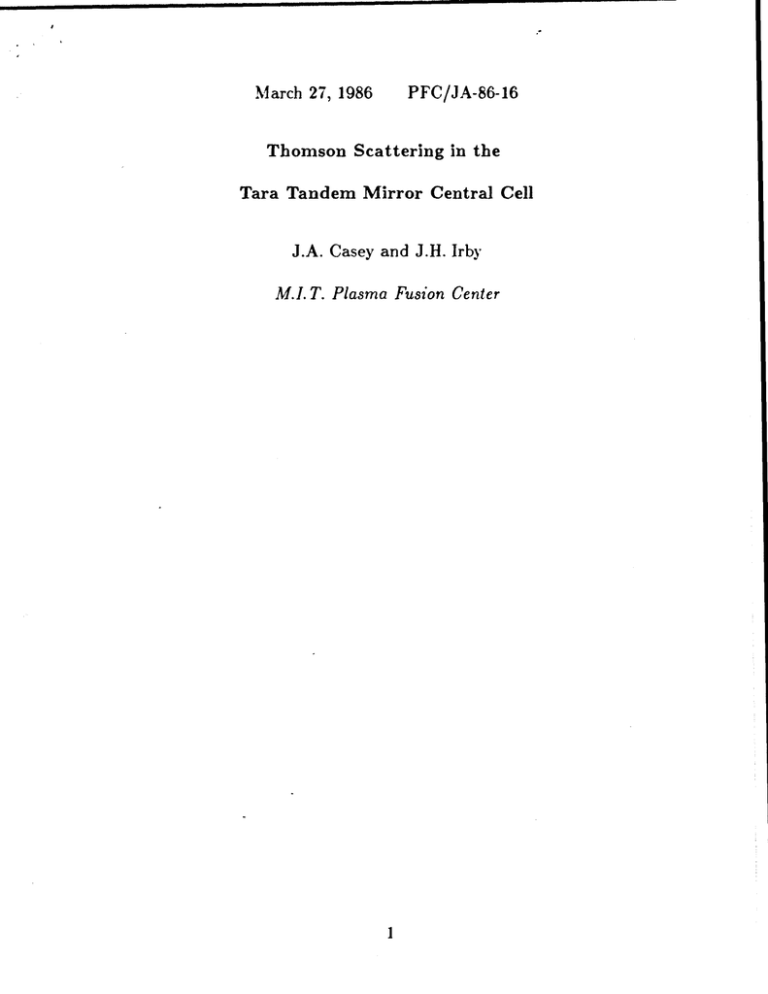27, 1986 Thomson Scattering in the PFC/JA-86-16
advertisement

March 27, 1986 PFC/JA-86-16 Thomson Scattering in the Tara Tandem Mirror Central Cell J.A. Casey and J.H. Irby M.I.T. Plasma Fusion Center I ABSTRACT: A Thomson Scattering experiment is under construction for the central cell of the Tara Tandem Mirror. This experiment has been designed to measure electron temperature and density at densities as low as 3 x 10"cm- 3. The measurement is made at a single time-point per shot using a Holobeam 10 J Qswitched Ruby laser, folded back for two passes through the scattering volume. Detection is at 90 degrees with f/5 optics. The optical table is mounted on linear bearings with a 10 inch stroke, so that the radius of the scattering volume may be changed from shot to shot. Novel features of the experiment include a high-throughput (> 25%) commercial triple-grating polychrometer using holographic gratings, and a directly coupled ten channel micro-channel plate photo-detector array. 2 INTRODUCTION: The need for optical diagnostics in fusion experiments at low densities has generated continued interest in improving the efficiency of scattering experiments. We have taken advantage of recent technological ad- vances in the manufacture of holographic gratings and microchannel plate photodetectors in the design of the Tara central cell Thomson scattering system. 3 x 10 laser. This system is designed to measure T and ne at densities below 1 cm~ 3, with ten channel resolution using a 10 J Q-switched ruby Previous low density measurements' have required higher power lasers and lower resolution; a combination of these techniques would conceivably extend the range of Thomson scattering to below 10 1 1 cm-3. The experiment has been installed on Tara, and is now undergoing alignment and electronics tests. We plan to be operational by late March 1986. DIAGNOSTIC REQUIREMENTS: Tara is a tandem mirror with axisymmetric plug cells and outboard quadrupole minimum-B anchors 2 . Neutral beam and ECRH heating in the plugs provide electrostatic confinement in the axisymmetric central 3 cell, while MHD stability is provided by the low-density hot-electron anchor. The central cell is 10m long, with an r = 20cm plasma confined by a 2 kG field. ne ~~2 - 4 X 10 Central cell parameters with plugging are predicted to be 1 cm-3, and Te ~ 200 - 400eV. We calculate that we will observe 170 photon counts in the high-A channel at these parameters. To be useful, good statistics must be obtained on single shots at one tenth of this density, leaving little allowance for additional losses or noise. Additional requirements for the experiment include radial scanning capability, intensity calibration for density measurements normalization, incorporation into the Tara computer control and data acquisition system, and window protection from titanium gettering. OPTICAL TABLE: Figure 1 shows the optical table. This is a two level, 41 x80- table with three vertical arms of "Optical-Erector-Set" (OES) attached. (a rigid vertical bench made of 8" x 11 1 stainless-steel rods). aluminum plates sliding on four The laser is mounted on the top level and the beam is directed through the right OES into the Tara vacuum vessel. 4 The polychrometer is mounted on the lower level, and collection optics are installed in a short OES arm which scans over a large rectangular window. The side windows are protected from gettering by line-of-sight shielding, and the top window by a pneumatically actuated shutter which opens immediately prior to the shot. Radial scans of the scattering volume are made by sliding the table assembly on linear bearings. All focusing and aiming optics are mounted rigidly to the table, so that the laser and detection optics and the scattering volume translate as a single fixed unit. The 10" table stroke sweeps the scattering volume from the machine axis to beyond the plasma edge. Movement is motor driven under computer control. An auxillary optical bench (not shown) is mounted under the axis of the machine, and contains an alignment laser and calibration flashlamp directed up through a 3" window. Detection optics throughput can be measured with the flashlamp while the table is centered over this port. LASER: We use a Holobeam two-stage Q-switched ruby laser, with 10 J capability in 20-30 nsec pulses. The beam is steered down one of the 5 OES arms into the vacuum chamber and brought to a focus. The signal strength is doubled by folding the exit beam back along itself (almost parallel), with separation from the incident beam occuring at the beam dump near the spatial filter aperture. POLYCHROMETER: The polychrometer is a commercially built, triple grating design based on the varioilluminator principle 3 ' 4 with a 25 A/mm dispersion. The high noise rejection from this type of design practically eliminates the need for critical beam entrance baffling and view dumps. The holographic gratings used in the polychrometer further reduce stray light by a factor of 100 over ruled gratings. In addition, the grat- ings are manufactured on curved surfaces to eliminate relay lenses. The polychrometer shows > 25%c throughput, and rejection of the unshifted 6943 A ruby light noise is better than 10'0. Both the collection lens and the polychrometer collect at f/S. thus only two relay lenses are necessary to image the beam focus on the entrance slit while "filling, the polychrometer. Since the collection f-number matches that of the polychrometer, the magnification is one and the length 6 of beam path imaged is equal to the entrance slit length (1.5 cm). DETECTOR: The detector is an ITT F4149 10x 10 micro-channel plate photomultiplier array, mounted directly on the polychrometer. The photocathode has a quantum efficiency of > 5% over the blue-shifted doppler spec- trum (6500-6900 A). The anodes are deposited directly on the back of the micro-channel plate, and are wired parallel in rows of ten, making ten strip-detectors covering the exit aperture of the polychometer',6. The ten anodes couple directly to fast charge sensitive digitizers, with 0.5 pC/bit sensitivity or two photo-electrons/bit at an MCP gain of 106. This ar- rangement has the triple advantage of dispensing with lossy fiber optics coupling. relative insensitivity to magnetic fields, and a single gain/voltage calibration for all channels. The detector/polychrometer combination has a dispersion of 44.3 A/channel. and the offset is fixed so that Ha emission (at 6563 confined to one channel. SENSITIVITY: A) is We require a statistically significant Te measurement in one shot. We have modeled our sensitivity assuming minimal cumulative losses (20%) from optical surfaces, a 10 J laser pulse, and MCP gain of 106. We calculate the number of counts expected per channel over the detection (blue-shifted) band, add estimated noise from plasma light (Bremsstrahlung and He), and allow for random fluctuations of signal and noise. Figure 2 shows a histogram of simulated data at the predicted Tara plugging parameters. A \/N weighted regression on the total minus background levels (averaged from several readings per shot) yields quite accurate T, results. At lower densities (~ 3 x 10 11 cm fluctuation levels becomes significant, and 3 ), the relative V'K TeTe increases to ~ 25%. At this point, we feel the single-shot sensitivity is lost, although multi-shot averaging may yield useful results. DENSITY CALIBRATION: We also desire to calibrate the laser energy and system throughput in order to measure electron densities. PIN diode measurements of the laser intensity at the laser and after passage through the vacuum chamber normalize shot-to-shot variations in laser power and degredation of beam path optics. The flashlamp in the viewing dump calibrates detection 8 MMWAW optics throughput. The total system efficiency calibration factor cannot be measured by Rayleigh scattering from Nitrogen as is standard, since the polychrometer will not pass the unshifted 6943 A laser line. A technique has been developed 6 using rotational Raman anti-Stokes scattering at higher pressures of Nitrogen, and will be used here. CONCLUSIONS: Thomson scattering in the Tara central cell will take advantage of state-of-the-art technology to maximize sensitivity at low densities. Sin- gle shot Te and ne measurements will be made at densities as low as 3 x 10"cm". The system will be operational by late March 1986. We are glad to acknowledge the engineering design by M. Olmstead, and funding by Department of Energy contract DE-ACO2-78ET51013. 9 Figure Captions: 1) The optical table is shown in relation to the Tara central cell. The upper bench (A) holds the laser, spatial filter, beam dump, and 180' folding optics. The beam is steered down the right Optical-Erector-Set (OES) arm (B) into the Tara vacuum vessel (C) through a 3" window and brought to a focus in the scattering volume. The diverging beam exits the chamber and is reflected nearly parallel back for a second pass (D). The beam dump is on the table top near the spatial filter aperture. The lower table holds the triple-grating poly- chrometer (E), and a short section of OES with the collection optics. The collection lens is mounted in an adjustable- height tube carried immediately above a large rectangular (4" x14") window (F). The entire table assembly slides on linear bearings for radial scans on a shot-to-shot basis; all optics and the scattering volume move as a fixed unit. 2) A simulation of data including statistical fluctuations, Bremsstrahlung. and H, emission for predicted Tara plug- ging parameters of Te ; 300eV and ne a 3 x 10 10 2 cm- 3 shows good signal to noise (except in channel 8., which includes He). A regression on this data (after subtracting the average noise level) yields Te = 299eV, with cT, = 6eV. 11 References: 1. J.A. Cobble, Rev. Sci. Instrum. 56, 1018 (1985). 2. J. Kesner, R.S. Post, B.D. McVey, and D.K. Smith, Nucl. Fusion 22, 549 (1982). 3. In this design, the second grating recombines the beam, rather than adding further dispersion. Between the second and third gratings, the beam passes through a narrow slit, thus stray light outside of the pass band is attenuated far more than in a design using multiple wide slits. 4. M. Greenwald, W.I.B. Smith, Appl. Optics 16, 567 (1973) 5. Multipoint scattering at higher density has been done by digitizing each channel individually. forming simultaneous spectra of ten spatial locations, (see next reference). 6. F.M. Levinton. G.A. Navratil, Rev. Sci. Instrum. (1983) 12 54, 35 A LLAF~N~.__ .1! -- -. 1 ___ 1B I I A: -m 'a -- 111 2-R K -- I 2 -- ( ly * ~ I~ ILW 3 III ~ III -I FIE Tl- it cJ r ~ Ay JL 200 100- 1 2 3 4 5 6 7 8 Chonnel Number 9 10






